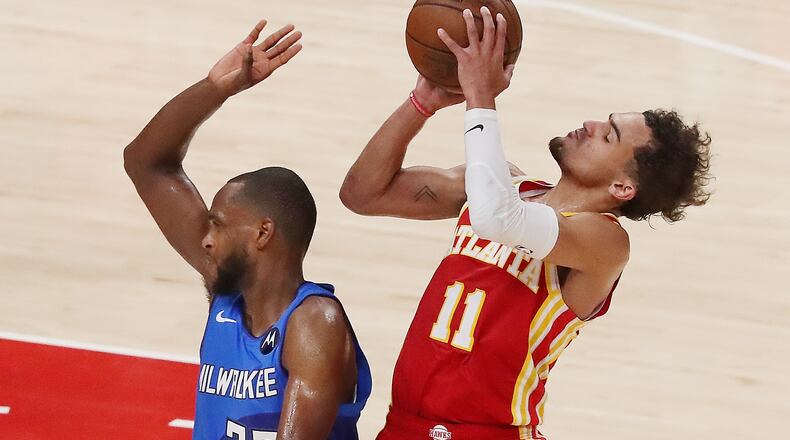This upcoming NBA season, you may notice one major difference in the way officials enforce the rules.
There will be a concerted effort to disincentive offensive players from using non-basketball moves to draw fouls, a growing trend in the NBA in recent years. Many players, including the Hawks’ Trae Young and the Nets’ James Harden, have mastered drawing contact and consistently getting to the line, but this new interpretation of the rules by referees may necessitate some adjustments.
The initiative emerged from the NBA’s competition committee and the idea to restore some balance between offense and defense — when it comes to calling fouls.
“Anything that fits those abrupt, or abnormal non-basketball moves by offensive players, we’re going to work on getting more defensive balance and offensive balance, so that competition, which is what the NBA is so great at selling, can be more (equal),” said Monty McCutchen, senior vice president and head of referee development and training. “Some of our best basketball is defensive basketball, and we don’t want to take that away from our players and our teams.”
Officials, who have had classroom sessions on the topic, will implement this new strategy in Summer League, which began Sunday. Summer League is mostly officiated by G League referees.
Some of the “non-basketball moves” officials will be looking for include pump-faking and jumping into a defender to draw contact and shooters using overt, abrupt, or abnormal launch angles. That may mean kicking out sideways or forward, or lurching forward. Another is an offensive player veering off his path (sideways or backward) into a defender, or hooking a defender while attempting a shot in a non-basketball manner.
Although there may be an adjustment period to start the NBA season, McCutchen feels teams will quickly adjust to officials’ new points of emphasis.
“We have the best players, the best athletes, the best coaches,” McCutchen said. “The positive of that is, if we do our work consistently, and that’s my responsibility to get our group to work consistently, not perfect, but consistently excellent work. If we do this change of interpretation correctly, our players and coaches will adapt quickly.
“They have proven that time and time again. Right now, the rules are out of balance, or the interpretation of the rules is out of balance. And as such, our fantastic players are using the rules to their advantage. If we are consistent with our work as officials, they will realize they can’t do that anymore, they will adjust quickly and we’ll get back to a game that is played the way it should be played.”
The biggest challenge for officials, McCutchen said may be calibrating what “abrupt and abnormal launch angles” look like. However, they’re not going in blind, as they’ve already been training and watching tape.
Some X’s and O’s on the new interpretation of the rules: pump-faking is still a part of the game, and it’s still a defensive foul if the defender bites and compromises his legal position, but it has gotten to where a defensive player can’t close out on an offensive player, McCutchen said, because the offensive player is lurching forward several feet. The offensive player can still drift forward a bit, but can’t launch.
There will obviously still be plenty of instances where defenders legitimately foul offensive players. One such example: if a defender is tailgating directly behind an offensive player, the offensive player can stop at any time he wants, anywhere on the court, to take a shot. If the defender runs into the offensive player, it’s a defensive foul.
But, what officials will try to get better at, per McCutchen, is the “snake-around,” where in the open court or around a screen an offensive player who has an angle to the basket chooses to jump in front of a defender quickly and then stop. That would be a no-call or an offensive foul if the offensive player were to jump backward. If an offensive player is tailgated by a defender and they’re on their way to the basket, and they stop to shoot, that could be a defensive foul. What officials don’t want is an offensive player taking a quick lateral step in front of a defender and then stopping. That could be a no-call or an offensive foul, depending on the play.
If an offensive player is coming around a screen and stops, and a trailing defender runs into their side, that’s still a defensive foul, unless the offensive player abruptly launches back into them. That would fall into the new category.
The same concept applies in transition.
Regarding drives to the basket: if an offensive player has a lane to the basket and a defensive player has a parallel line to the basket, one thing officials want to clean up is offensive players veering and running into the defender. That’s different than if the defender is the one who knocks the offensive player off that parallel line. If a defender is trying to beat an offensive player to a spot and launches into them, that’s still a blocking foul.
When an offensive player is taking a normal shot from distance, which obviously will include a slight drift forward, it will still be a defensive foul and potentially a flagrant foul if a defender tries to take that landing spot away.
“We want players to be able to shoot safely, land safely and play the game with an understanding that they’re not going to be out three weeks because they took a normal jump shot,” McCutchen said.
About the Author
Keep Reading
The Latest
Featured


